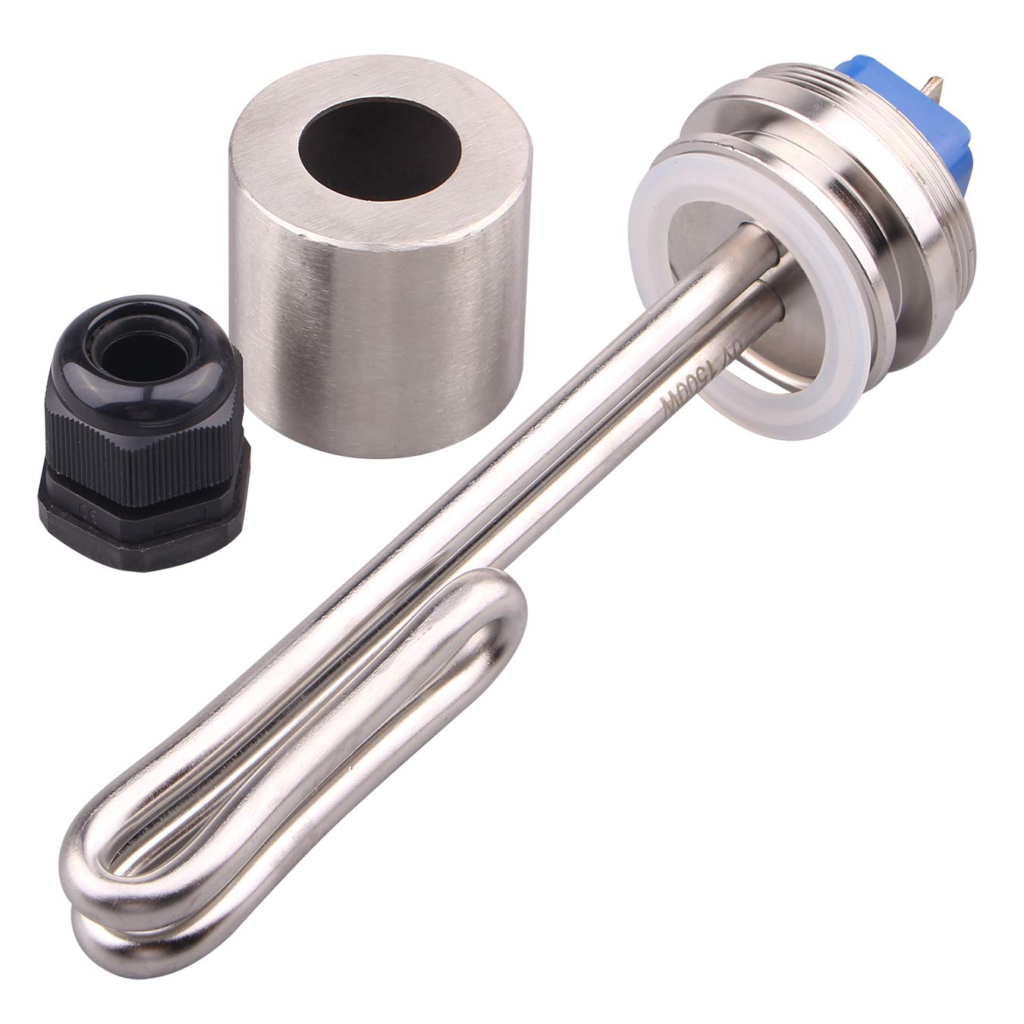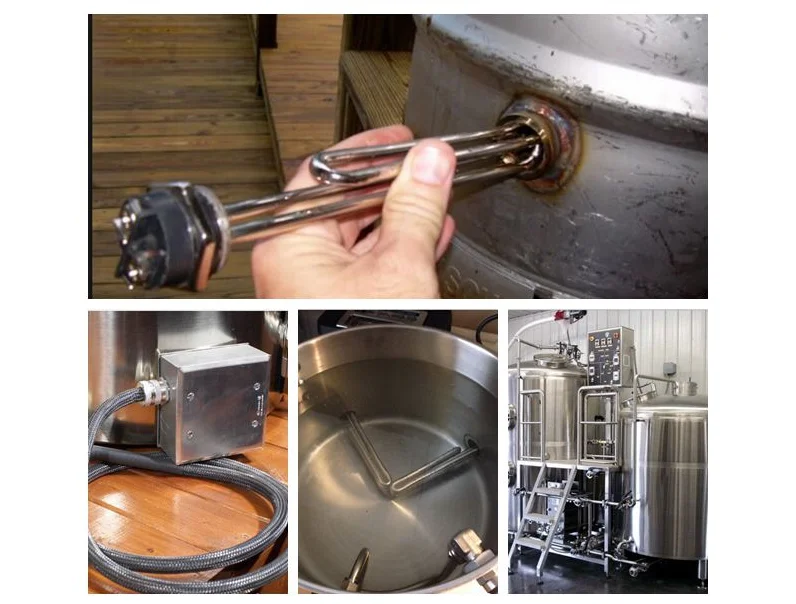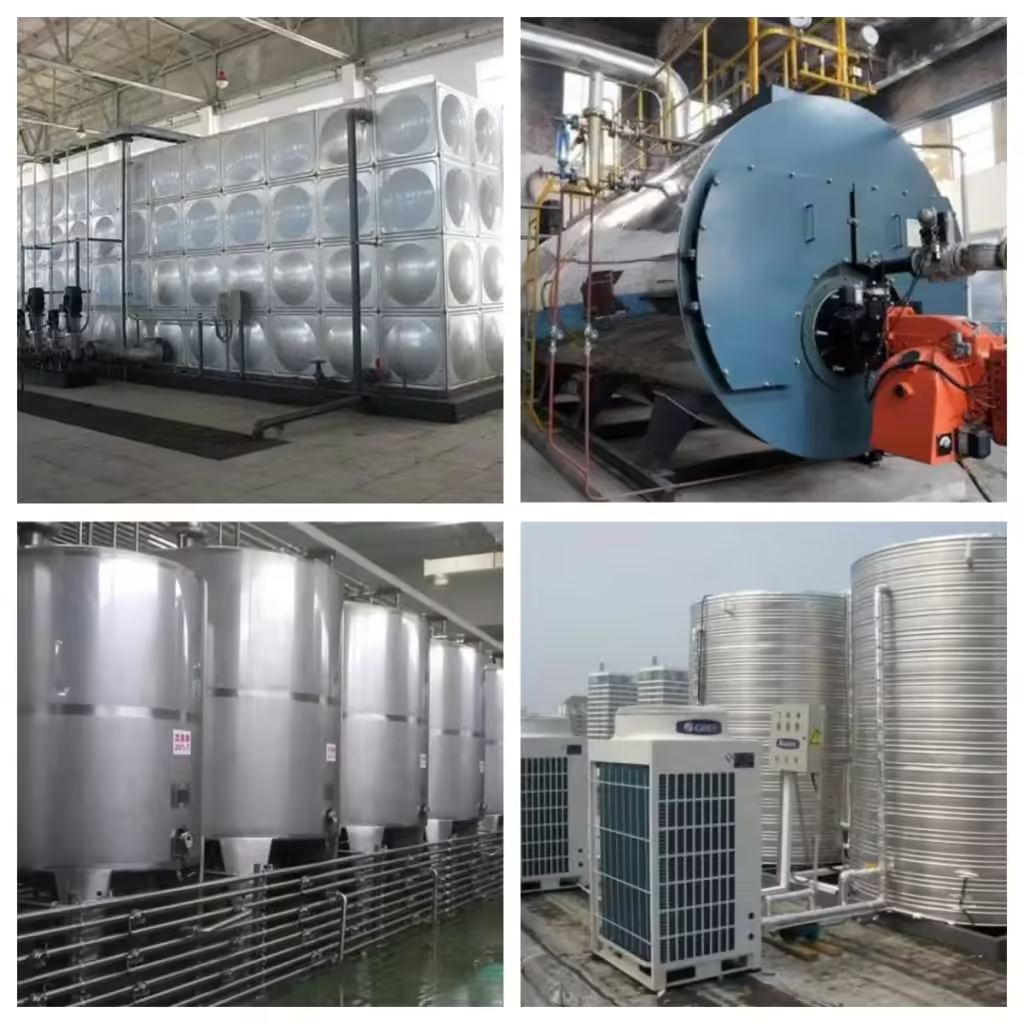Introduction to Heating Element
Heating elements play a crucial role in the functionality of various household and industrial appliances. Essenzialmente, they are devices designed to convert electrical energy into heat energy through different physical processes, thus providing the necessary warmth for numerous applications. The significance of heating elements cannot be overstated, as they are integral to the operation of essential appliances such as water heaters, ovens, and dryers, to name a few.
At their core, heating elements primarily operate on the principle of Joule heating, where an electric current passing through a conductor generates heat. This process occurs due to the resistance encountered by the electric current within the heating element materials, which typically include metals like nichrome or iron. The heat generated is then transferred to surrounding environments or materials, thereby facilitating tasks such as cooking food, drying clothes, or heating water.
There are several common types of heating elements utilized in everyday appliances. For instance, resistive heating elements are widely used in electric ovens and toasters, employing a direct form of heat transfer that provides efficient cooking or browning. Another type is immersion heating elements, frequently found in water heaters, where the element is submerged in the fluid to rapidly raise its temperature. Lastly, radiant heating elements, commonly seen in underfloor heating systems and some cooktops, distribute heat more evenly across surfaces, enhancing comfort and cooking efficiency.
Understanding the various types of heating elements and their respective functions is essential for selecting the right component for specific needs. This knowledge not only aids in appliance performance but also ensures energy efficiency and longevity, ultimately contributing to more sustainable usage practices in our daily lives.

Identifying Your Appliance Type
When selecting the right heating element for an appliance, it is crucial to first identify the type of appliance that requires the heating element. Various appliances utilize heating elements, and each type has specific characteristics that influence the selection process. Notable examples include electric stoves, water heaters, toasters, and ovens. Understanding the functionality and requirements of these appliances will aid in making an informed decision about the suitable heating element.
Electric stoves are among the most common appliances that rely on heating elements. These appliances typically utilize coil elements or smooth surface elements, which may be either radiant or induction types. Radiant heating elements are designed to heat the surface and transfer the heat to the cookware, while induction heating elements produce a magnetic field that directly heats the pan. Therefore, the choice between these options will depend on the type of cooking desired and the compatibility with the cookware used.
Water heaters are another essential appliance category that employs heating elements. For instance, tank-type electric water heaters often feature immersion heating elements, which can be either single or dual elements. In this case, the selection of the heating element must consider factors such as tank capacity, recovery rate, and energy efficiency. Furthermore, tankless water heaters utilize specially designed heating elements that provide on-demand heating, necessitating a distinct approach to element selection.
Toasters and ovens also incorporate heating elements, with toasters typically utilizing exposed wire elements to achieve quick heating. Al contrario, ovens may use concealed heating elements for efficiency and safety. The wattage ratings, material composition, and size of the heating element can vary significantly across different appliance types. Therefore, it is essential to assess the specific needs and usage patterns to select the most fitting heating element for each appliance.
Understanding Heating Element Specifications
Heating elements play a crucial role in the functioning of various appliances, providing the necessary heat for processes such as cooking, drying, and heating. Selecting the appropriate heating element requires a comprehensive understanding of its specifications, including wattage, voltage, misurare, and material. Each specification significantly impacts the performance and efficiency of the appliance.
Wattage refers to the amount of power consumed by the heating element and is typically measured in watts. Higher wattage translates to increased heat output, enabling faster heating times. Conversely, a heating element with lower wattage may result in slower heating, which could be inefficient for certain applications. It is essential to choose a wattage that aligns with the requisite heating demands of the appliance to ensure optimal performance without excessive energy consumption.
Voltaggio, representing the electrical potential difference, is another critical specification. Appliances operate on different voltage ratings, including 120V and 240V. Selecting a heating element with the appropriate voltage rating is imperative, as using an element with a mismatched voltage can lead to inadequate performance or potentially cause damage to the appliance.
The size of the heating element is vital as well. A properly sized heating element ensures uniform heat distribution and prevents localized overheating, which can damage the appliance or food items. When considering size, it is important to refer to the manufacturer’s specifications to ensure compatibility with the appliance.
Lastly, the material of the heating element affects its durability and efficiency. Common materials include nickel-chromium alloy and ceramic. Each material has unique thermal properties, influencing how quickly the element heats up and maintains heat. Ultimately, understanding these specifications will inform users about the performance capabilities and energy efficiency of their heating appliance, ensuring a wise selection that meets their needs.
Determining Wattage Requirements
When selecting a heating element for an appliance, one of the most crucial factors to consider is the required wattage. The wattage determines the heating performance and efficiency of the appliance. To accurately determine the wattage necessary for your specific appliance, you can follow several guidelines and formulas.
Firstly, it is essential to assess the size of the appliance, as larger appliances typically require higher wattage to ensure effective heating. A basic formula to estimate the wattage needed is W = V × A, where “W” is wattage, “V” represents voltage, E “UN” is the current in amperes. By determining the voltage rating of your appliance, you can use this formula to calculate the minimum wattage needed.
Prossimo, consider the intended usage of the appliance. For instance, a slow cooker may require less wattage than a commercial-grade oven. To calculate the wattage based on usage, you can utilize the formula: W = (Required Temperature Change × Volume × Material Constant) / Time. This will give you a good estimate of the wattage necessary to achieve the desired heating performance for the specific material and volume you intend to heat.
Per esempio, if you want to heat a pot of water (which typically has a specific heat capacity of 4.186 J/g°C) weighing 2000 grams to a temperature of 100°C within 10 minutes, the required change can be calculated. The formula will yield an estimated wattage that reflects your heating needs.
It is important not to overlook safety margins when determining wattage requirements. A slight overestimation can ensure reliable performance without overloading the system. Inoltre, considering the appliance’s environment and insulation will further refine your wattage selection. Ensuring that the heating element matches these wattage needs will facilitate optimal appliance performance.
Measuring Existing Heating Element

Measuring an existing heating element accurately is essential for selecting an appropriate replacement. Following a systematic approach ensures that you gather all necessary dimensions and specifications effectively. Begin by ensuring your safety; disconnect the appliance from the power source to prevent any electrical hazards. Depending on the appliance design, you may need tools such as a screwdriver or pliers to safely access the heating element.
Once the power is disconnected and the appliance is opened, gently remove the heating element. If it is secured with screws, make sure to keep these screws in a safe place for reassembly. Use caution when handling the element, as it may still be warm if the appliance was recently used; allow it to cool completely beforehand.
Using a tape measure or ruler, measure the length of the heating element from end to end. Record this measurement clearly, as it is often a crucial factor in selecting a compatible replacement. Inoltre, measure the diameter of the element, especially if it is cylindrical. This information is particularly pertinent for finding substitutes that fit the specified space.
Pay attention to the shape of the heating element, whether it is straight, coiled, or bent, and document any specific features, such as the width or attachment points. Also, identify and measure any terminals or connectors, as these dimensions will be vital when ensuring electrical compatibility with your new element.
Finally, compile all measurements and characteristics noted during the process. Accurate documentation increases the likelihood that your new heating element will match the exact specifications necessary for optimal performance. This thorough approach not only provides confidence in your choice but also enhances the efficiency and safety of your appliance once the replacement is installed.
Choosing the Right Heating Element Material

When selecting a heating element for an appliance, the choice of material can significantly influence both performance and longevity. The most common materials used for heating elements include metal alloys, ceramica, and glass, each exhibiting unique properties that cater to various applications.
Metal alloys, such as nichrome, are frequently utilized due to their high resistance and ability to withstand high temperatures. These alloys provide excellent durability, which translates to a longer lifespan for heating elements. Inoltre, their efficiency in transferring heat makes them ideal for devices that require rapid heating. However, they may be prone to oxidation if exposed to moisture or corrosive environments, which can compromise their longevity.
Ceramic heating elements are another popular choice, particularly for their ability to maintain even temperatures and resist thermal shock. They are made from materials such as alumina and are often employed in applications where consistent heating is essential. While ceramic elements are generally efficient and resistant to wear, they can be brittle and, if mishandled, may crack under pressure. Their cost tends to be higher than that of metal alloy options, which may be a consideration for budget-conscious consumers.
Glass heating elements offer a more modern alternative, particularly in applications such as cooktops and certain types of heaters. They provide aesthetic advantages and are known for their easy cleaning capabilities. Glass elements evenly distribute heat, but they are less efficient compared to metal alloys and ceramics. Inoltre, they can be sensitive to abrupt temperature changes, making them less durable in high-stress environments.
Ultimately, the choice of heating element material should be guided by the specific needs of the appliance in question. Factors such as required durability, efficienza, and overall cost should inform the decision-making process, ensuring that the selected heating element meets both functional and economic expectations.
Consulting Product Manuals and Specifications
When it comes to determining the right heating element for your appliance, consulting product manuals and manufacturer specifications should be among the first steps taken. These documents serve as essential resources, offering critical information regarding the compatible components for each specific model. Most manufacturers provide comprehensive manuals that detail the specifications of their appliances, including the exact type of heating element required.
To effectively locate this information, start by retrieving the product manual that came with your appliance. If it is misplaced or not available, many manufacturers offer digital versions of their manuals on their websites. By searching for the model number of your appliance, which is often found on a label inside the door or on the back, you can access the appropriate documentation directly online. Once you have the manual, pay attention to the section addressing parts or components, where the specifications for the heating element are typically listed.
In addition to the manual, it is also advisable to check the manufacturer’s website for additional information and specifications. Many manufacturers include FAQs, troubleshooting guides, and forums, which can provide valuable insights and further clarify the requirements for your heating element. Another resource is online retail websites that sell replacement parts. These sites often include compatibility information that can confirm whether a particular heating element is suitable for your model.
When consulting these resources, be vigilant about noting the wattage, misurare, and type of heating element identified in the specifications. This ensures that you select a compatible model, preventing potential issues such as overheating or malfunctioning. In summary, consulting product manuals and specifications is a crucial step in selecting the right heating element for your appliance, ensuring both safety and performance.
Where to Purchase Heating Elements
When it comes to sourcing heating elements for your appliance, various purchasing options are available, each offering distinct advantages. One of the most convenient avenues is local appliance repair shops. These establishments often carry a range of heating elements suitable for various appliances. Inoltre, purchasing from these shops can provide the opportunity to receive expert advice on compatibility and installation, further ensuring you choose the right product for your needs.
Another common option is online retailers. Websites such as Amazon, eBay, and specialized appliance parts websites offer a vast selection of heating elements. The benefit of shopping online is the ability to compare prices and access customer reviews, which can help in making an informed decision. However, when purchasing online, be mindful of the return policies and warranties associated with the heating elements. A robust return policy can be particularly beneficial if the component is incompatible or not up to your standards, allowing for hassle-free exchanges.
Manufacturer websites also serve as a reliable source for purchasing heating elements. Buying directly from the manufacturer ensures that you receive genuine parts specifically designed for your appliance model. Many manufacturers provide detailed product specifications and installation instructions, which enhance the purchasing experience. Like with online retailers, it is wise to consider the warranty options offered, as some manufacturers may provide limited warranties on their parts, which can add peace of mind to your purchase.
Before making a final decision, taking the time to read product reviews and check the ratings of different suppliers can provide deeper insights into product quality and reliability. This approach ensures that you get the best heating element for your appliance while also protecting your investment. Ultimately, each purchasing option presents unique benefits, so consider your specific needs before proceeding.
Conclusion and Additional Resources
Selecting the right heating element for your appliance is crucial for optimizing its performance and efficiency. Throughout this blog post, we discussed several factors to consider, including the type of appliance, the heating element’s compatibility, wattage requirements, and energy efficiency. By understanding these key aspects, you can make informed decisions that meet your specific needs. Inoltre, knowing how to properly install and maintain your heating element enhances the longevity of the appliance and ensures consistent functionality.
In your quest to determine the ideal heating element, exploring additional resources can be beneficial. Numerous instructional videos are available online that guide you through the selection process, offering visual aids and expert tips that may clarify your options. Websites such as YouTube and dedicated DIY platforms often feature content that tackles common issues and questions related to heating elements in various appliances.
Inoltre, engaging with community forums can provide you with valuable insights and shared experiences from other users. Websites like Reddit and appliance repair forums allow individuals to connect and discuss their challenges and successes when replacing or upgrading heating elements. These platforms encourage knowledge sharing and can serve as helpful support systems during your selection process.
As you navigate through the process of identifying the right heating element, remember to prioritize safety and adhere to manufacturer guidelines. Allowing yourself time to research different elements will yield a suitable choice that enhances the functionality of your appliance. For further assistance, consider consulting with professionals who specialize in appliance repair and maintenance to receive personalized recommendations.
